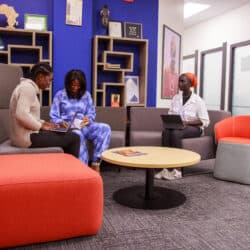When long-serving leaders leave their roles, what can we learn from them that will help our sector traverse the challenging times ahead?
The Philanthropist Journal recently sat down with four foundation leaders, two who have recently resigned from their roles and two who will do so shortly. In the first half of 2023, Bruce Lawson stepped down as president and CEO of Counselling Foundation of Canada, and Laura Manning left her role as executive director of the Lyle S. Hallman Foundation; Sandy Houston, president and CEO of the Metcalf Foundation, and Marcel Lauzière, president and CEO of the Lawson Foundation, will soon follow in their footsteps.
Metcalf, Lawson, and the Counselling Foundation have been around since the 1950s and have deep roots in Canadian philanthropy. Hallman was founded in 2003. As a group, they provide resources in the areas of diabetes care, community development, counselling and career development, the arts, children, families, communities, advocacy, and more.
Each foundation has its unique genesis story, and these leaders have been integral in navigating the tides. Houston, a lawyer by training, took on his leadership role 23 years ago. Lawson’s offer to help out two days a week at the Counselling Foundation of Canada quickly grew into a full-time job; he stayed at the helm for 14 years. Lauzière is in his 10th year (his longest tenure), and Manning had a 12-year run at Hallman.
We asked: What factored into your decision to step down?
“I think CEOs have a shelf life,” Manning says, “and it’s different for different people.” She relates a story about being at a conference and listening to a younger colleague speak passionately about new initiatives that could be implemented within the foundation and thinking, “Oh gosh, no!” That for her was a sign – she was losing her enthusiasm for the work. In her years at Hallman, she had helped to shift the way they funded organizations and felt she’d given all she could. That, along with wanting to spend more time with her family doing the things they’d planned for while they still could, sealed her decision.
I think CEOs have a shelf life, and it’s different for different people.
Laura Manning, previously of Lyle S. Hallman Foundation
Lawson felt he’d done most of what he wanted to do with the Counselling Foundation and did not want to run the show any more. There were other things in life he wanted to explore. Plus, he had a successor who’d been in the wings for a while and wanted to make way for that person to lead.
For Lauzière, turning 65 reminded him it was time to make room for someone else with new energy and new ideas to take the helm. He tendered his notice, incorporating six months of overlap time to allow the board and the new CEO to transition successfully.
The opportunity for renewal, new perspectives, new people, new ideas . . . factored into my decision.
Sandy Houston, Metcalf Foundation
Houston’s looming 65th birthday and the boost that a new leader with new ideas could bring to Metcalf influenced his decision. “A new leader will be making contributions to our sector that will be different and hopefully better than the ones I made, and that will be good. The opportunity for renewal, new perspectives, new people, new ideas for Metcalf factored into my decision.”
Take-away lesson #1: When you’ve done the best you can, and there are other things that beckon more, it is time to make way for someone else to lead.
We then threw out a list of questions to the four leaders and asked each to select one they most wanted to answer.
What wisdom do you have to impart about your time in the sector? (chosen by Marcel Lauzière)
Lauzière prefaces his response by acknowledging what a privilege it has been to serve in an organization where he has so much latitude to innovate. “The sky is the limit for foundations like ours,” he says. “I’ve seen a lot of change in the last 10 years – impact investing, more diversity, the way we interact with grantees.” He advises his peers to continue to innovate. “The collaborations we are increasingly seeing among foundations is really important,” he says. “Continue to learn how to better engage with organizations on the ground. We now understand that everyone has an asset they are bringing to the table. We have the dollars. That’s our asset. The organizations know community, they know what the issues are, and they often know what the solutions are. Let’s keep on working on that and push foundations to do even better on that front, because that’s a huge privilege.”
The collaborations we are increasingly seeing among foundations is really important.
Marcel Lauzière, Lawson Foundation
Lawson adds his take, recalling his first Philanthropic Foundations Canada meeting, where a speaker said that foundations were the first to foist collaborations on their recipients and the last to collaborate among themselves. Lawson resolved to change that perception. During his tenure at the Counselling Foundation, he facilitated collaborations with a number of organizations, including crowd-sourcing around Indigenous learning. Tangible results can be seen in the creation of Foundation House and the Philanthropic Community’s Declaration of Action. “This was an opportunity for us to have a different methodology and leverage other assets other than financial – relationships, for example – to make change happen.”
Take-away lesson #2: Collaborate, collaborate, collaborate!
What do you think has been the most significant change in the non-profit landscape over the years? (chosen by Sandy Houston)
“With respect to the non-profit sector, the degree of change over the last 20 years has been remarkable, and most of it positive,” Houston says. He has seen significant shifts in the way charities are funded, from a focus on funding symptoms to funding diagnoses. “Let’s think about causation and systems and structure. We are trying to achieve social change. What flows from that is a focus on collaboration and policy that we didn’t see before. Power is a perennial conversation. We have privilege and money. What can foundations do to make that power more distributed and less closely held is an ongoing discussion in our field.” Increased transparency, more collaborations, and patience are practices he recommends for sector leaders.
Take-away lesson #3: Leverage your influence to facilitate systemic changes.
What has anchored you in this work over the years that has stood the test of time and you’d think beneficial for an incoming CEO to embrace? (chosen by Laura Manning)
“Remembering it’s not my money,” Manning says. “It’s the community’s money.” She says this mantra shaped the way she worked and allowed her the freedom to remain focused on the work and not be distracted by those who sought to curry favour. She recalls a very early CEO retreat when someone remarked that “the definition of a foundation executive is someone who never had a bad meal or a sincere compliment.” That stayed with her, along with some advice from an experienced leader when she started at Hallman: “You have to learn how to be part of and apart from at the same time.” She acknowledges the challenge of leadership. “When you are in the position to influence where resources go, you have to understand the players to know where the community is moving, but you have to maintain enough distance so you are making decisions in an informed way.”
Take-away lesson #4: Know your community so you can make informed decisions.
What brings you the most joy? (chosen by Bruce Lawson)
“The privilege that you can jump on something as it presents itself” kept Lawson energized throughout his tenure. “Or,” he adds, “an opportunity you can’t pass up . . . and you ride that wave for a period of time.” It is also knowing when to lead and when to follow. For him, the Workforce Funder Collaborative was a great opportunity to look at an issue from multiple angles.
“And,” Manning interjects, “the thing that I thought was always special was that we are not fundraising. We don’t need our name on anything or credit. We just want to help. And that’s an incredible freedom.”
“It’s not about us,” Lawson says. “It’s about the thing we are supporting.”
“Foundations,” Lauzière adds, “can influence public policy. We need to do a better job at getting governments to understand that. We have the ability to convene – we are not out there looking for dollars, support, or permission. Governments usually have difficulty convening groups. Foundations have the ability to bring different people to the table and take risks with those conversations.”
It’s not about us. It’s about the thing we are supporting.
Bruce Lawson, previously of Counselling Foundation of Canada
Lauzière notes that foundations have credibility and access that other organizations may not. They are exposed to a lot of field practice and they also understand government structures. “Foundations,” he says, “need to better use our social capital to influence change.”
“The degree to which foundation boards understand that and are comfortable operating in this space differs,” Manning says. “The way you change conditions, primarily, is to change policy.”
Take-away lesson #5: Foundations can influence policy by bringing other voices to the table.
We asked: Coming out of the pandemic, what are things you think will keep a new CEO up at night?
Manning: “The embedding of and understanding of equity into the work – that’s the big thing. How does one effectively engage in reconciliation? How do you change the thinking of folks around the table? How do you think differently about where the funds are going?”
Lauzière: “We are living in a more polarized world. People feel that things are broken. How do we play a role in helping everyone in society depolarize things and hope that democracy does not suffer in the process?”
Houston: “The sense of urgency has ramped up. The pathway is harder – more challenging, in making change in a world where urgency is present.”
Lawson: “People are talking over one another and living in different universes. There’s an erosion of trust in institutions. Where can we play a role?”
Take-away lesson #6: Be very aware of the times we are in and the salient issues that must be addressed.
We asked: Think about your tenure and what you have loved about your job. Is there a story, a defining moment, that made you glad you were in this space to do it?
Houston: “I spend my days surrounded by bright, passionate people who have great ideas. And you get to make one of these things happen. That’s an extremely satisfying part of the work.”
Lawson: “I loved going out and putting a new face on the foundation and building a new reputation. The relationships, the collaborations brought me such joy. I loved working with people who are incredibly committed to their communities. The things I am proudest of are the things that brought people together to address a big problem. A few colleagues and I wondered what could be done during the pandemic to support Indigenous communities. Ten weeks later something happened, and I can hold my head up high that I was a small part of that.”
Manning: “In June of 2020, when we went into lockdown, the board was asking what is the best Hallman could do to support the community. Our team had conversations with all the organizations we funded in the last year and asked them what they needed most. We compiled all they told us.” [Manning and her team crunched numbers and then presented to the board a whopping $8- to $9-million relief package that would enable the organizations they funded to function for another year – with only two reporting questions.] “The relief that brought to the organizations was huge! I’ve never worked so hard during my life, but this is one of the accomplishments I’m most proud and happy to have been a part of.”
Lauziere: “Working with the colleagues around the table. The imagining and building of Foundation House was a big, big joy. When the Lawson Foundation signed on to the Declaration of Action, the board told us we had to follow through. That meant we had to work differently than how we had in the past. We put together an ambitious plan for how we could best serve Indigenous communities. When we brought the plan to our Indigenous advisors, they tore it apart. It was a very humbling experience. The advisors challenged us to move from the deficit approach to an asset approach. That was great learning!”
Take-away #7: Continue to innovate, collaborate, learn, push for change while practising patience, leverage your influence, and build relationships to make things better not just for some, but for everyone in society.
***
There you have it. More than 60 years of collective wisdom crystalized into seven takeaway lessons. Strong reminders that the work we do matters and that thousands of people count on us to keep doing it – better, more inclusively, and together. It requires shifting some paradigms, debunking some assumptions, but with the firm belief that we can co-create the solutions needed in these times for effective and sustainable community building. These takeaways must never retire when leaders do.
In the next instalment, we will take a deep dive into what boards are doing to attract and retain the right leaders for the times we are in.


